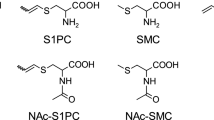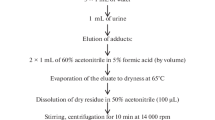Abstract
Two mercapturic acids, i. e., N-acetyl-S-(1-cyano-2-hydroxyethyl)-l-cysteine (CHEMA) and N-acetyl-S(2-hydroxyethyl)-l-cysteine (HEMA), were isolated from the urine of rats dosed with four successive doses of oxiranecarbonitrile (glycidonitrile, GN), 5 mg/kg, a reactive metabolic intermediate of acrylonitrile (AN). GC-MS analysis of methylated urine extracts from both AN- and GN-dosed rats showed another mercapturate which was identified as N-acetyl-S-(1-cyanoethenyl)-l-cysteine (1-CEMA) methyl ester using an authentic reference sample. The mass spectrum of this compound was very similar to that of a methylated metabolite of AN tentatively identified by Langvardt et al. (1980) as N-acetyl-3-carboxy-5-cyanothiazane (ACCT). In contrast, no ACCT was found in rats dosed with either GN or AN. Hence, there is no evidence for the formation of ACCT or its isomers in rats dosed with AN or GN. The methyl ester of 1-CEMA is formed artificially by dehydration of CHEMA methyl ester in the injector of the gas chromatograph.
Similar content being viewed by others
References
Abreu ME, Ahmed AE (1980) Metabolism of acrylonitrile to cyanide: in vitro studies. Drug Metab Dispos 8 (6): 376–379
Ahmed AE, Patel K (1979) Studies on the metabolism of aliphatic nitriles. Toxicol Appl Pharmacol 48: A 91
Bladeren PJ van, Delbressine LPC, Hoogeterp JJ, Beaumont AHGM, Breimer D, Seutter-Berlage F, van der Gen A (1981) Formation of mercapturic acids from acrylonitrile, crotonitrile and cinnamonitrile by direct conjugation and via an intermediate oxidation process. Drug Metab Dispos 9 (3): 246–249
Černá M, Koči>ová J, Kodýtková J, Kopecký J, Šram RJ (1981) Mutagenic activity of oxiranecarbonitrile (glycidonitrile). In: Gut I, Cikrt M, Plaa GL, (eds) Industrial and environmental xenobiotics. Springer, Berlin Heidelberg New York, pp 251–255
Dudley HC, Neal PA (1942) Toxicology of acrylonitrile (vinyl cyanide). I. Study of the acute toxicity. J Ind Hyg Toxicol 24 (2): 27–36
Duverger-van Bogaert M, Lambotte-Vandepaer M, Meester C de, Rollmann B, Poncelet F, Mercier M (1981) Effect of several factors on the liver extract mediated mutagenicity of acrylonitrile and identification of four new in vitro metabolites. Toxicol Lett 7: 311–319
Geiger LE, Hogy LL, Guengerich FP (1983) Metabolism of acrylonitrile by isolated rat hepatocytes. Cancer Res 43: 3080–3087
Guengerich FP, Geiger LE, Hogy LL, Wright PL (1981) In vitro metabolism of acrylonitrile to cyanoethylene oxide, reaction with glutathione and irreversible binding to proteins and nucleic acids. Cancer Res 41: 4925–4933
Gut I, Nerudová J, Kopecký J, Holeček V (1975) Acrylonitrile biotransformation in rats, mice and chinese hamsters as influenced by the route of administration and by phenobarbital, SKF 525A, cysteine, dimercaprol, or thiosulphate. Arch Toxicol 33: 151–161
Hashimoto K, Kanai R (1965) Studies on the toxicology of acrylonitrile, metabolism, mode of action and therapy. Ind Health 3 (1–2): 30–45
Hoffmann P, Kleine D, Franzen E (1976) On the proof of acrylonitrile exposure: Detoxication of acrylonitrile by coupling with d-glucuronic acid (in German). Z Ges Hyg 22 (5): 310–312
Holeček V, Kopecký J (1981) Conjugation of glutathione with acrylonitrile and glycidonitrile. In: Gut I, Cikrt M, Plaa GL (eds) Industrial and environmental xenobiotics. Springer, Berlin Heidelberg New York, pp 239–245
Kopecký J, Šmejkal J (1984) Simple preparation of acrylonitrile metabolites: Oxiranecarbonitrile and 2, 3-dihydroxypropionitrile (in German). Z Chem 24 (6): 211–212
Kopecký J, Zachardová D, Gut I, Filip J (1979) Acrylonitrile metabolism in the rat in vivo (in Czech). Pracov Lék 31 (6–7): 203–207
Kopecký J, Gut I, Nerudová J, Zachardová D, Holeček V, Filip J (1980) Acrylonitrile metabolism in the rat. Arch Toxicol Suppl 4: 322–324
Kopecký J, Šmejkal J, Linhart I, Hanuš V, Tureček F (1984) Reaction of oxiranecarbonitrile with l-cysteine methyl ester. Tetrahedron Lett 25 (8): 4295–4298
Lambotte-Vandepaer M, Duverger-van Bogaert M, Meester C de, Rollmann B, Poncelet F, Mercier M (1981) Identification of two urinary metabolites of rats treated with acrylonitrile; influence of several inhibitors on the mutagenicity of those urines. Toxicol Lett 7: 321–328
Lambotte-Vandepaer M, Duverger-van Bogaert M, Rollmann B (1985) Metabolism and Mutagenicity of acrylonitrile: an in vivo study. Environ Mutagen 7: 655–662
Langvardt PW, Putzig CL, Braun WH, Young JD (1980) Identification of the major urinary metabolites of acrylonitrile in the rat. J Toxicol Environ Health 6: 273–282
Maltoni C, Ciliberti A, Di Maio V (1977) Carcinogenicity bioassays on rats of acrylonitrile administered by inhalation and by ingestion. Med Lav 68: 401–411
Milwy P, Wolf M (1977) Mutagenic studies with acrylonitrile. Mutat Res 48: 217–278
O'Berg MT (1980) Epidemiologic study of workers exposed to acrylonitrile. J Occup Med 22: 245–252
Seutter-Berlage F, van Dorp HL, Kosse HGJ, Henderson PT (1977) Urinary mercapturic acid excretion as a biological parameter of exposure to alkylating agents. Int Arch Occup Environ Health 39: 45–51
Sharaief Y, Brown AM, Backer LC, Campbell JA, Westbrook-Collins B, Stead AG, Allen JW (1986) Sister chromatid exchange and chromosome aberation analyses in mice after in vivo exposure to acrylonitrile, styrene or butadiene monoxide. Environ Mutagen 8 (3): 439–448
Venitt S, Bushell CT, Osborne M (1977) Mutagenicity of acrylonitrile (cyanoethylene) in Escherichia coli. Mutat Res 45 (2): 283–288
Author information
Authors and Affiliations
Additional information
Details of the synthetic procedures and NMR-spectra are available from the authors on request
Rights and permissions
About this article
Cite this article
Linhart, I., Šmejkal, J. & Novák, J. N-ccetyl-S-(1-cyano-2-hydroxyethyl)-l-cysteine, a new urinary metabolite of acrylonitrile and oxiranecarbonitrile. Arch Toxicol 61, 484–488 (1988). https://doi.org/10.1007/BF00293695
Received:
Accepted:
Issue Date:
DOI: https://doi.org/10.1007/BF00293695




